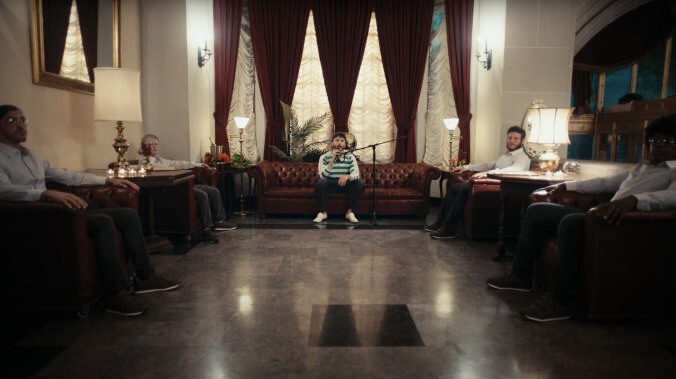Go deep inside a Masonic temple with The Armed for a fascinating concert film
ULTRAPOP: Live At The Masonic Temple is a narrative-driven concert film—in the loosest sense of the word—by the hardcore provocateurs

It’s a truism that most musicians, when agreeing to be filmed in live performance, hope for nothing more than to capture the electric you-are-there frisson generated from a concert. Yet anyone who’s listened to a recording or seen footage of a show they attended knows that’s an impossible ask—and the best concert films generally try to use the cinematic medium to their advantage, creating something different from but as vital as the difficult-to-replicate sensation of watching a great artist perform in person.
ULTRAPOP: Live At The Masonic Temple, the new concert-meets-arthouse-whatzit film from conceptual hardcore band The Armed (which begins digital screenings October 15), splits the difference. There’s a linear but elliptical narrative running through the hour-long movie—as intriguing, and ultimately elusive, as the band itself—but there’s also the musical performances themselves, committed to tape via intimate and audience-free sets. And these are so vivid, immediate, and invigoratingly shot that they come close to that ongoing dream of re-creating the intensity of seeing a great band up close and personal.
The question posed by any concert film that includes a non-documentary narrative element is whether it’s worthwhile cinema or self-indulgent hogwash. The fear, in other words, that you’ll end up with something akin to The Song Remains The Same’s fantasy sequences. Luckily, there are no shots of band members riding white horses through the British countryside, here: What we get with Masonic Temple is closer to outtakes from a David Lynch movie than preening rock iconography.
Moving from room to room inside Detroit’s strange and massive Masonic Temple, the footage resembles nothing so much as scenes from Inland Empire, albeit with better-quality cameras. Here, a front entrance waiting room populated by a deep-sea diver, a furry, and more; there, a rooftop psychic conversation between a woman painted gold and the band’s Dan Greene (or rather, “Dan Green,” as per the credits and the band’s zealous secrecy about who is actually a member of The Armed). “Have I lost the narrative? Is this out of control?” Green asks the mysterious woman. “Not yet,” she responds, and the exchange works just as well as a meta comment on the thematic thrust of the film as it does within the context of the movie.
In keeping with the group’s commitment to ambiguity and an ever-shifting lineup of musicians, each time The Armed strikes up another track, it’s in a different room, with a slightly different roster. The general procession of the narrative—the Svengali-like “Green” figure overseeing the performances, conveying the members through the halls, and pontificating on the authenticity of the experience, before joining in the music—maintains an icy distance from the viewer, the better to let the constant stream of symbolism and metatextual references remain open to interpretation. (Though it gets awfully close to student-film preciousness during a conversation Green has with himself in a mirror.)
What’s most interesting about Masonic Temple, however, is how it wouldn’t really work without the overwhelming potency of the band’s live performances. Take away the music, and all the distinctive set design and swirling cameras really would feel like weak interstitials straining for profundity. But the conception and execution of the narrative element does serve the music: It’s both borne of it and commenting on the lyrical meanings contained therein, as open for interpretation as they are. In other words, the ass-kicking songs justify the oblique segments, making them greater than the sum of their parts—just as ULTRAPOP as a whole exceeds its individual songs.
And that’s part of the fun of watching this odd little concert film: You can take it as seriously or as lightly as you choose, and it works either way. “The world isn’t actually watching,” the Green character intones at one point. “No one’s invested… no one cares.” But rather than embracing nihilism, he says, he sees this as freedom. And so should the viewer: Invest however you like, because ultimately, the power of the film—and its make-of-it-what-you-will narrative—still resides in what you draw from The Armed’s robust, cathartic noise.